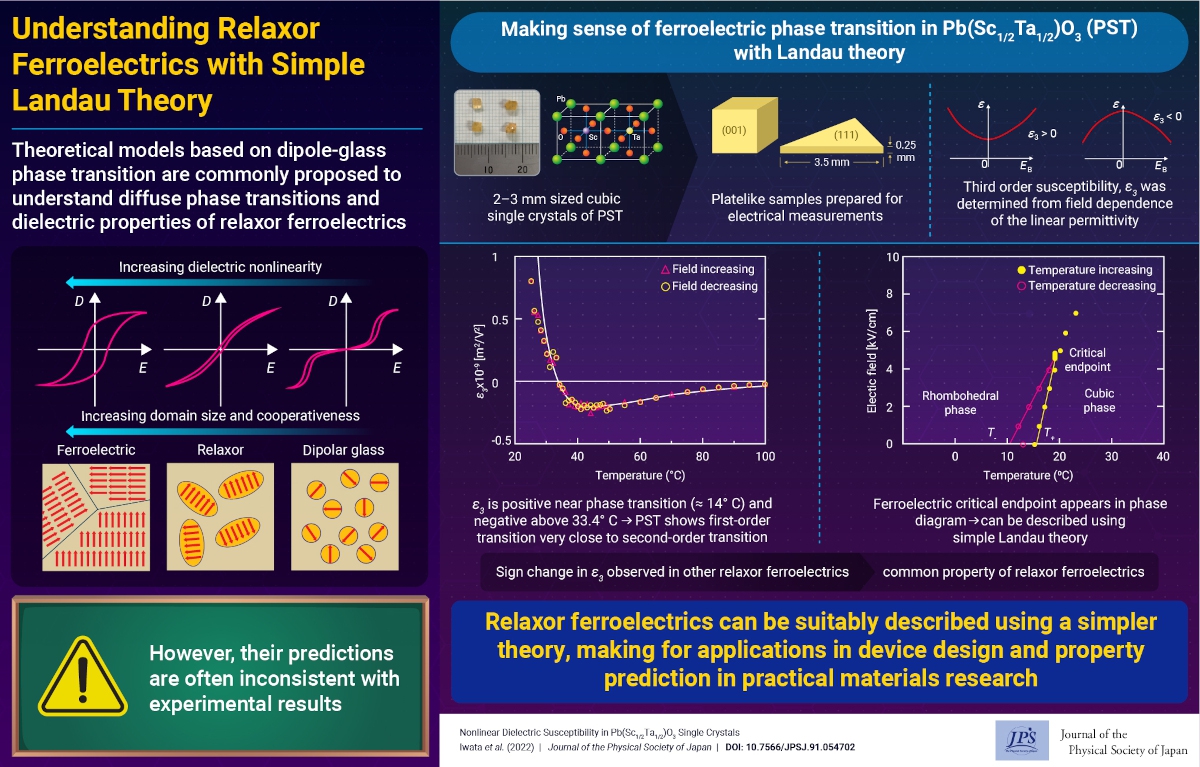Understanding Relaxor Ferroelectrics with Simple Landau Theory
© The Physical Society of Japan
This article is on
Nonlinear Dielectric Susceptibility in Pb(Sc1/2Ta1/2)O3 Single Crystals
J. Phys. Soc. Jpn.
91,
054702
(2022)
.
Third-order nonlinear dielectric susceptibility is measured in the paraelectric phase of Pb(Sc1/2Ta1/2)O3. The linear and nonlinear dielectric susceptibility results can be consistently explained based on the Landau-type free-energy density.

Pb(Sc1/2Ta1/2)O3(PST) is a perovskite-type ferroelectric oxide that exhibits relaxor-like characteristics. A relaxor is a material that exhibits a diffuse phase transition with a wideband dispersion in dielectric permittivity over many orders of magnitude. One of the most challenging issues in the physics of ferroelectrics is to understand the inherent dielectric properties of relaxor ferroelectrics.
To explain the physical properties of relaxors, many theoretical models based on the dipolar-glass transition have been proposed wherein the third-order nonlinear dielectric susceptibility e3 was theoretically predicted to indicate a negative divergence at the dipolar-glass transition temperature. However, it has been reported that in some relaxor ferroelectrics, the measured e3 takes positive values without any indication of divergence near the temperature Tm at which the linear permittivity is maximum. This is inconsistent with the predictions made by the theoretical models based on the dipolar-glass phase transition. Therefore, to explain the temperature dependence of e3, a new model is required. The ferroelectric critical endpoint (CEP) in the temperature–field phase diagram in many perovskite relaxor ferroelectrics has been extensively investigated. The PST temperature–field phase diagram has been obtained, and the existence of ferroelectric CEP was demonstrated. The appearance of the ferroelectric CEP in relaxors implies that relaxor ferroelectrics can be investigated based on the simple Landau-type free-energy density, similar to a conventional ferroelectric material, without any complex models based on dipolar-glass phases. Under these circumstances, in the present study, the linear and nonlinear dielectric susceptibilities in the paraelectric phase of PST were measured. The results were explained based on the Landau-type free-energy density.
The experimental results reveal that e3 takes a positive value near Tm (approximately 14 °C) and becomes negative above T1 = 33.4 °C. It was concluded that the positive e3 near Tm in PST results from the first-order transition because the sign of b (coefficient of the fourth-order term of the polarization in the Landau-type free-energy density) directly depends on the sign of e3. Furthermore, a change in the sign of e3 near the transition temperature in PST indicates that b is relatively small, thereby implying that the phase transition in PST is close to the second-order transition. Such a change in the sign of e3 in paraelectric phase has been reported for several perovskite-type ferroelectrics, such as BaTi1–xZrxO3, PZN–PT, and PMN–PT, which indicates that it might be a property common to many perovskite ferroelectrics.
In this study, the relationship between the third-order susceptibility e3 and ferroelectric phase transition in PST was clarified based on macroscopic thermodynamics.
(written by M. Iwata on behalf of all authors)
Nonlinear Dielectric Susceptibility in Pb(Sc1/2Ta1/2)O3 Single Crystals
J. Phys. Soc. Jpn.
91,
054702
(2022)
.
Share this topic
Fields
Related Articles
-
Qualitative Changes in Kinetic Pathways Driven by Hydrodynamic Interactions in Dense Colloidal Suspensions
Cross-disciplinary physics and related areas of science and technology
Statistical physics and thermodynamics
Structure and mechanical and thermal properties in condensed matter
2025-4-18
Even in dense colloidal suspensions, where long-range hydrodynamic interactions are screened, near-field hydrodynamic interactions qualitatively influence the selection of kinetic pathways.
-
Exploring the Vibrant Interplay of Machine Learning and Physics
Cross-disciplinary physics and related areas of science and technology
Electron states in condensed matter
Elementary particles, fields, and strings
Mathematical methods, classical and quantum physics, relativity, gravitation, numerical simulation, computational modeling
Statistical physics and thermodynamics
Superconductivity
2025-3-13
This Journal of the Physical Society of Japan Special Topics edition explores how physics and machine learning complement each other and can solve unresolved problems in physics.
-
Bayesian Insights into X-ray Laue Oscillations: Quantitative Surface Roughness and Noise Modeling
Measurement, instrumentation, and techniques
Structure and mechanical and thermal properties in condensed matter
2025-2-14
This study adopts Bayesian inference using the replica exchange Monte Carlo method to accurately estimate thin-film properties from X-ray Laue oscillation data, enabling quantitative analysis and appropriate noise modeling.
-
Hyperuniform and Multifractal States in Bosonic Quasicrystalline Systems
Statistical physics and thermodynamics
Structure and mechanical and thermal properties in condensed matter
2025-2-10
Quantum states can be categorized as hyperuniform or multifractal based on electronic characteristics. This study demonstrates that bosonic quasicrystalline systems exhibit hyperuniform or multifractal quantum states.
-
Exploring Materials without Data Exposure: A Bayesian Optimizer using Secure Computation
Cross-disciplinary physics and related areas of science and technology
Measurement, instrumentation, and techniques
2025-2-6
Secure computation allows the manipulation of material data without exposing them, thereby offering an alternative to traditional open/closed data management. We recently reported the development of an application that performs Bayesian optimization using secure computation.




